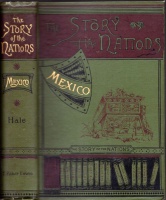kategóriák
- Közlekedés ajánlójegyzék
- Szocreál ajánlójegyzék
- Reklám ajánlójegyzék
- Fotó ajánlójegyzék
- Kínai-japán ajánlójegyzék
- Szentkép ajánlójegyzék
Új árakkal! - Új szentkép ajánlójegyzék II.
- 12 érdekes régiség
 Könyv
Könyv
 Bibliofilia
Bibliofilia
 Régiség
Régiség
 Metszet
Metszet
 Térkép
Térkép
 Fotó
Fotó
 Papírrégiség, Aprónyomtatvány
Papírrégiség, Aprónyomtatvány
 Plakát
Plakát
- Cirkusz
- Modern grafika
- Szocreál
- NER Irodalom
- Egyéb
kosár
üres a kosár
nincs bejelentkezve
Hale, Susan : Mexico
- leírás
- további adatok
Sorozat: The Story of the Nations
Tartalom: I.
PAGE
The Subject 1-11
View from a steamer, 1—Seen by Fernando Cortés, 2; his ambition, 3—Inhospitable coast, 3—Vera Cruz, 4—Departure, 4—Climate we leave, 5—Climate we are seeking, 5—Three climates of Mexico, 6—Anahuac, 6; Tierra templada, 7—Scenery of the plateau, 7—Its early inhabitants, 8—Destroyed by Cortés, 8—Traditions of Anahuac, 9—Teocallis changed to cathedrals, 9—The Conquistadores, 10—Spanish rulers, 10—Two emperors, 10—Mexico a republic, 11; its past and future, 11.
II.
Shadowy Tribes 12-23
Meaning of Anahuac, 12—Tula, formerly Tollan, 13—The Toltecs, 13—Cholula: its legends, 14, 15, 16, 17, 18, 19, 20—Mound builders, 21—Legends of the Nahuas, 21—Huehue-Tlapallan, 22—Atlantis, 22—Noah of the Mexican tribes, 22—Universal fable of the deluge, 23.
III.
Traditions of the Toltecs 24-37
Their wanderings, 24; ruins of their capital, 26; their resources, 26; language, 27; early faith, 27—Cuernavaca, 28—Toluca, 28—Power of their ruler, 29—Quetzalcoatl, The Shining Snake, 29; legends of his career, 30; possible facts, 32; mystery of his departure, 32; image in the museum, 33; his attributes, 33—Evil days of the Toltecs, 34—The Agave Americana, 34; its properties, 35—Maguey, 35—Xochitl, 36; her beverage, 36—Deterioration of the [Pg viii] Toltecs, 37; dates of their wanderings, 37.
IV.
Chichimecs 38-44
A new dynasty, 38—The Chichimecs, 39; occupations and customs, 39—The mark of a warrior, 39—The Serpent of the Clouds, 40—The invasion of Xolotl, 40—Fall of Tollan, 41—Territory of Xolotl, 41—New waves of emigration, 42—Wise rulers, 42—Texcuco, 42—The Aztecs, 43—War with Atzcapotzalco, 44—Kingdom of Texcuco, 44.
V.
Nezahualcoyotl 45-52
The young prince, 45; in captivity, 45; a faithful friend, 46—Tlaxcaza, 46—The plateau to-day, 46—The Malinche, 46—The Land of Bread, 47—A wise tutor, 47—Maxtla, 48—The homage of Nezahualcoyotl, 48—Maxtla's plot, 48—Open enmity, 49—Nezahualcoyotl's escape, 49; his hiding, 50—Tyranny of Maxtla, 50—The true prince triumphant, 51—Maxtla defeated and killed, 51—The kingdom of Texcuco Acolhuacan, 52.
VI.
Texcuco 53-61
The Golden Age, 53—The government, 53—Council of Music, 53—Texcucan literature, 54—Lost treasures, 54—A royal poet, 55—The Laughing Hill, 56—Artificial lakes, 56—Ruins of Tezcotzinco, 56—Baths of Montezuma, 57—A blot on Nezahualcoyotl's fame, 57; a Mexican Haroun al Raschid, 58; his religion, 59—From anarchy to civilization, 59—Nezahualpilli, 59—Decline of Texcuco, 60—A Texcucan historian, 60—Legend or fact? 61.
VII.
Michoacan 62-69
The Land of Fish, 62—Lonely lakes, 62—Patzcuaro, 63—The Place of Delights, 64—The first settlers, 64—Iré Titatacamé, 65—A dusky princess, 65—Tixiacurí, the first king of Michoacan, 66—The kingdom divided, 66—Tzintzuntzan, 67—The glorious reign of Zovanga, 67—A city of [Pg ix] birds, 67—Fruitless excavations, 68—The Tarascans, 68.
VIII.
Mayas 70-82
The first wave of migration, 70—Traces of Mayas in Yucatan, 70—A great empire, 71—Nachan, the town of serpents, 72; its ruins discovered, 72—Palace at Palenque, 72—Lofty chambers and strange bas-reliefs, 73—The Temple of the Cross, 74—An emblem of Christian faith, 75—Meaning of the tablets, 75—Chichen-Itza, 76—A religious centre, 77—Paintings and bas-reliefs, 78—Chaak Mool, the tiger-chief, 78—The beautiful Kinich, 78—Tomb of Chaak Mool, 78—Paved roads of Yucatan, 79—Votan and Zamna, 80—Mayan legends, 80—Weapons and armor, 81—War with the Toltecs, 82.
IX.
Aztecs 83-95
Best known of the Anahuac tribes, 83—Aztlan, 83—The migration, 84—Six centuries of wanderings, 84—The name Mexican, 84,—Their adopted home, 84—Chapultepec, 86—Driven to the islands, 87—A wretched life, 87—Valor of the slaves, 87—An abiding city, 87—Tenochtitlan, or Mexico, 88—Advances in civilization, 88—Results of modern research, 89—A king chosen, 90—Early years of the kingdom, 91—The Princess of Cloth, 92—Canoas, 92—Chimalpopoca, 94—The usurpation, 94—Maxtla, 95.
X.
Mexicans 96-110
Itzcoatl, 96—Alliance with Texcuco, 96—War with Maxtla, 96—Victory of the allies, 97—Fall of the Tepanec monarchy, 97—"The Valley Confederates," 98—Reign of Motecuhzoma, 98—Height of the Mexican power, 98—Conquest of the Chalcas, 99—Inundation and famine, 99—Raid upon neighboring provinces, 100—Laws of Motecuhzoma, 100; his successor, 101—Tizoc, 101—The Drinking-cup of the Eagle, 101—Human sacrifice, 102—Temple built by Tizoc, 105—Dikes, 105—A despot, 106—Extent of the kingdom, 106—Religious fanaticism, 108—Doubtful [Pg x] records, 109.
XI.
Aztec Character 111-123
Unreliable testimony, 111—Hieroglyphics, 111—Paintings, 112—"Wanderings of the Aztecs," 112—Religion, 114—A future life, 114—Funeral customs, 114—Domestic life, 115—Laws, 115—Music, 115—The Aztec calendar, 115—Divisions of time, 116—Names of days, etc., 117—Opinions of antiquarians, 117—The cycle, 118—Unlucky days, 118—Agriculture, 119—Irrigation, 119—A gentle race, 120—The Priestesses, 121—Coatlicue, the goddess of the earth, 122—Source of Aztec greatness, 122—A fatal policy, 123.
XII.
The Last of the Montezumas 124-134
Motecuhzoma Xocoyotzin, 124; his character, 124—A coronation festival, 125—Royal robes, 125—The life of an Aztec king, 126; his capital, 126—Diaz's description, 127—A life of pleasure, 128—State correspondence, 128—Chapultepec, 129—Montezuma's cypress, 129—Clouds on the horizon, 130—Sinister predictions, 130—The coming of the white men, 131—An unhappy monarch, 131—Landing of the strangers, 132—Velasquez de Léon, 132; his expedition to Yucatan, 133—Grijalva visits Mexico, 133—Montezuma's embassy, 133.
XIII.
Cortés 135-144
Birth, 135; enters the army, 135; visits Cuba, 135—An attractive portrait, 135—Defects of character, 136—Velasquez and Grijalva's expedition, 136—A love story, 137—Cortés receives a commission, 137; his companions, 137—Jealousy of Velasquez, 137—The squadron, 138—Jérome d' Aguilar, 138—First conflict with the Aztecs, 139—Palm Sunday, 139—A happy people, 140—Rumors of danger, 140—Presents to the strangers, 141—Cortés as Quetzalcoatl, 141—Easter, 141—A perplexed council, 142—Mistaken policy, 142—Vera Cruz, 142—Cortés visits Cempoallan, [Pg xi] 143—Tlaxcalla, 143—The ships destroyed, 144.
XIV.
Malintzi 145-150
Her birthplace, 145—The little duchess is made a slave, 145—Life in Tabasco, 146—Arrival of Cortés, 146—Treaty of alliance, 146—The heiress-slave becomes a Christian, 146—Marina or Malinche, 146—A new interpreter, 147—A beautiful picture, 147—Splendid gifts, 148—Malintzi's beauty, 149; her devotion to Cortés, 149; its result, 149.
XV.
Tlaxcalla 151-157
An isolated province, 151—Exaggerated reports, 151—Efforts for the friendship of the Tlaxcallans, 152—A trap for the Spaniards, 152—A battle, 152—Defeat of the Tlaxcallans, 153—Peace concluded, 153—Christianity introduced, 153—Cholula, 154—Slaughter of the Cholultecas, 154—Alliance with Ixtlilxochitl, 154—Cacamatzin imprisoned, 155—Cortés reaches Mexico, 156—Cortés and Montezuma, 157—A lesson and a vow, 157.
XVI.
La Noche Triste 158-165
Overtures of friendship, 158—Bold measures, 159—Montezuma in the power of the Spaniards, 159—A rival in the field, 159—Alvarado, 160—The feast of Huitzilopochtli, 160—The Spaniards in danger, 160—Death of Montezuma, 161—Mexican traditions, 162—Cortés abandons the city, 163—A desperate struggle, 163—La Noche Triste, 164—The scene of the battle, 164; the losses, 165.
XVII.
Conquest 166-179
An interval of peace, 166—The new emperor, 166—A legacy of the Spaniards, 167—Cortés in extremis, 167—The Aztec army, 168—Battle at Otumba, 170—The Spaniards victorious, 170—Preparations for defence, 171—The Spaniards in Tlaxcalla, 171—Ixtlilxochitl, 171—Cortés at Texcuco, 172—A new army and a new fleet, 172—The [Pg xii] campaign against Mexico, 173—Suffering in the city, 174—Surrender, 174—The city destroyed, 175—Cortés at Coyoacán, 175—Search for treasures, 175—The kings tortured, 175—Military rule, 176—Subjugation of Michoacan, 176—Later conquests, 177—Death of the Aztec kings, 178—Later life of Cortés, 178; return to Spain, 178; death, 178; burial in Mexico, 179.
XVIII.
Doña Marina 180-183
Her position in the camp, 180—After the victory, 180—Life at Coyoacán, 180—Arrival of Doña Catalina, 181; her death, 182—Insurrection in Honduras, 182—Marriage of Marina, 183; her later life and her death, 183—Cortés visits Spain, 183—A second marriage, 183.
XIX.
Indians 184-190
The conquest complete, 184—The name Indian, 184—Origin of the Nahuatl tribes, 185—Distinguished from the North American Indian, 186—Military government, 188—The Ayuntamiento, 188—The Audiencia, 188—Nuño de Guzman, 189; his cruelty to the natives, 189—Guadalajara founded, 189—A second Audiencia, 189—A viceroy appointed, 190—Extent of New Spain, 190.
XX.
The First of the Viceroys 191-202
Antonio de Mendoza, 191; his family and character, 191—Reforms instituted, 191—Industries encouraged, 192—The Franciscans, 192—Fray Pedro, 192—Foundation of schools and colleges, 193—Guadalajara and Valladolid, 193—Michoacan and its people, 194—The founding of a city, 195—Spanish families in Mexico, 196—Jews and Moors banished, 196—Vasco de Quiroga, 197; his life in Tarasco, 197; his church at Tzintzuntzan, 198—A wonderful picture, 198—The cathedral at Morelia, 199—Cortés goes to Spain, 200—Popularity of the viceroy, 200—First Mexican book, [Pg xiii] 202—Departure of Mendoza, 202.
XXI.
Fray Martin de Valencia 203-213
Don Luis de Velasco, second viceroy, 203—New institutions and industries, 203—Puebla de los Angeles, 204; the tradition of its founding, 204; the situation, 206—The early ecclesiastics, 207—The worship of the Virgin, 207—The "twelve apostles of Mexico," 208—Fray Martin of Valencia, 208; his life in Amecameca, 209; his death, 210—Relics of Fray Martin, 211—An object of reverence, 212—Death of Velasco, 212—A well-regulated government, 213.
XXII.
Other Viceroys 214-223
Events in Spain, 214—Philip II., 214—The character of the viceroys, 215—The Inquisition, 216—The Quemadero, 216—Death of Philip, 217—Inundations, 217—Martinez and his canal, 218—Successors of Philip, 219—Wars of succession, 220—Revillagigedo, 220; anecdotes of his administration, 221.
XXIII.
Humboldt 224-232
A distinguished visitor, 224; he arrives in Mexico, 225—Remarks on the carving, 225—Academy of fine arts, 226; its later history, 227—The cathedral, 227—Humboldt at Chapultepec, 228; The market, 228—Teotihuacan, 229—Mexican mines, 229—Valenciana, 229—At Patzcuaro, 230—The birth of a volcano, 231.
XXIV.
Revolutions 233-237
Charles III. of Spain, 233; his successor, 233—Branciforte and the statue of Charles IV., 234—Napoleon invades Spain, 235—A change of government, 235—Juntas, 235—The Bourbons restored, 235—Iturrigaray and his administration, 236—Revolt in the air, 237—The policy of Spain, [Pg xiv] 237—Venegas, 237.
XXV.
Hidalgo 238-249
Birth and education, 238—Colegio de San Nicholas, 238—He takes orders, 238; life at Dolores, 240; bold schemes, 240—Ignacio Allende, 241; An important step, 241—The Grito de Dolores, 242—A new army, 242—Attack on Guanajuato, 243—A brave boy, 243—The new viceroy, 243—Hidalgo excommunicated, 244—Valladolid taken, 245—Monte de la Cruces, 245—The insurgents defeated at Aculco, 246—Hidalgo declared Generalissimo, 246—Battle of Calderon, 247—Capture and death of the chiefs, 248—End of the struggle for independence, 248.
XXVI.
Morelos 250-257
Birth and family, 250—Morelia, 251—Muleteer and student, 251—Morelos joins Hidalgo, 251—Siege of Cuautla, 252—Acapulco, 252—First Mexican Congress, 252—Declaration of independence, 253—Attack on Valladolid, 253—Mishaps, 254—Morelos a prisoner, 254—Death of Morelos, 255; his character and aims, 255; his object achieved, 256.
XXVII.
Yturbide 258-271
The close of Calleja's administration, 258—The insurgents dispersed, 258—Apodaca and Guerrero, 259—Affairs in Spain, 259—Agustin de Yturbide, 260; early services, 260; meets Guerrero, 261—"Plan of Iguala," 261—The "three guaranties," 261—Advance of the insurgents, 262—The viceroy deposed, 262—A successful campaign, 263—O'Donojú, 263—Treaty of Cordova, 264—Yturbide enters the capital, 264—The Regency, 264—The Mexican Empire founded, 265—Work of the new government, 265—Second Mexican Congress, 265—Yturbide proclaimed Emperor, 266—Signs of dissatisfaction, 267—Santa Anna, 267—The Casa-Mata, 268—Yturbide banished, 268; his return to Mexico, 270; his execution, 270; character of Yturbide, 271. [Pg xv]
XXVIII.
Santa Anna 272-280
A confused story, 272—Santa Anna, 273; his connection with Yturbide, 273—The Constitution, 273—"Guadalupe" Victoria, 273—Expulsion of the Spanish, 274—A presidential election, 274—Mutiny in the capital, 275—Colonization of Texas, 276—Pedraza, 276—A Spanish invasion, 277—Santa Anna made Commander-in-Chief, 277—Bustamente, 278—Guerrero betrayed and shot, 278—Santa Anna becomes President, 278—Farías, 279—Insurrection in Texas, 279.
XXIX.
Still Santa Anna 281-289
Louis Philippe, 281—Reclamacion de los pasteles, 281—The French repelled, 281—Santa Anna's home, 282—Bustamente recalled, 282—Trouble again, 283—Mejia, 283—A revolution described, 284—Bustamente resigns, 288—Santa Anna triumphant, 288.
XXX.
Society 290-300
Madame Calderon's journal, 290—An ambassador from Spain, 290—State of society, 291—The Paséo, 291—The Viga, 292—Women in Mexico, 292—Good-Friday in Mexico, 294—Robbers, 297—Guardias Rurales, 298—A monarchy proposed, 299.
XXXI.
Rumors of War 301-310
Results of the Spanish rule, 301—Playing at independence, 301—The appeal to arms, 302—The country exhausted, 302—Misfortunes, 304—The United States, 304—Spread of its territory, 304—Colonization of Texas, 305—Moses Austin, 304—Revolt against Mexico, 305—Houston and Santa Anna, 305—Texas independent, 305—Annexed to the United States, 306—Herrera, Farías, and Paredes, 307—The [Pg xvi] Mexican army, 308.
XXXII.
War Begun 311-322
The beginning of hostilities, 311—Palo Alto and Resaca de la Palma, 311—The war carried into Mexico, 312—Difficulty of negotiation, 312—"Indemnity for the past," 313—California, 313—Policy of the United States, 313—Monterey taken, 314—Fremont enters the capital, 316—Taylor's campaign, 316—Siege of Monterey, 318—Ampudia's proclamation, 319,—Paredes and his "Plan," 319—Santa Anna again, 320—Fall of Paredes, 321—Santa Anna at the capital, 321—A new army, 321.
XXXIII.
Puebla Lost 323-332
Scott before Vera Cruz, 323—Buena Vista, 323—Raising money, 323—The religious orders and their influence, 324—Wealth of the Church, 326—Ecclesiastical property seized, 327—Bombardment of Vera Cruz, 328—The city surrenders, 328—Cerro Gordo, 330—Santa Anna at Puebla, 330—Puebla occupied by the Americans, 331—Guadalupe and its surroundings, 331—Santa Anna as Dictator, 332—Patriotism aroused, 332.
XXXIV.
Chapultepec Taken 333-341
The approach to the capital, 333—Churubusco, 333—Docile Indians, 333—Another victory for the Americans, 334—Molino de Rey, 334—Chapultepec taken, 336—Occupation of the capital, 336—Treaty of Guadalupe Hidalgo, 338—Discovery of gold, 338—Effects of the war, 339—Attempts to capture Santa Anna, 340—Santa Anna retires to Jamaica, 341—Grant in the Mexican war, 341.
XXXV.
Benito Juarez 342-347
Peace restored, 342—Herrera and his administration, 342—Santa Anna again Dictator, 344—An epoch of reform, 344—Clerigos and liberales, 344—Benito Juarez, 344; his early life, 345; governor and exile, 345; restored to office, 346—A new Constitution, 346—Juarez becomes President, 346—Foreign [Pg xvii] intervention, 347.
XXXVI.
French Intervention 348-356
A foreign squadron, 348—The pretext and the cause, 348—Spain and England withdraw, 349—The policy of Napoleon III., 349—A proposed empire, 349—Maximilian, 350; dreams of "the right divine," 352—The French troops advance on the capital, 353—Divisions in Mexico 353—The Cinco de Mayo, 354—A bold attack, 355—Defence of Puebla, 356.
XXXVII.
The Empire under Protection 357-364
The sovereigns arrive, 357—The imperialist party, 357—Reception of Maximilian, 358—Relics of royalty, 359—Military affairs, 360—The new government, 362—Chapultepec restored, 363—Society at the capital, 363—Apparent prosperity, 364.
XXXVIII.
The Unprotected Empire 365-372
Action of the United States, 365—Responsibility for the intervention, 366—The final word of Napoleon, 367—Carlotta goes to Europe, 368—Her interview with Napoleon, 369—Maximilian leaves the capital, 370—At Orizaba, 371—Father Fischer, 371—The Emperor's manifesto, 372.
XXXIX.
Maximilian 373-382
The French army withdrawn, 373—Advance of Juarez, 374—The Emperor and his attendants, 374—Investment of Querétaro, 375—Márquez and Diaz, 375—Personal appearance of the Emperor, 376—The treachery of Lopez, 377—Maximilian a prisoner, 378; his death, 380.
XL.
End of the Episode 383-385
General Vidaurri, 383—The escape of Márquez, 384—General Diaz, 384—Puebla, 385—Vigor of the liberal government, [Pg xviii]385.
XLI.
The Last of Santa Anna 386-391
Juarez enters the capital, 386—Peace established, 387—Santa Anna in retirement, 387; his exile and death, 388—Character of Juarez, 389—Civil war again, 390—Death of Juarez, 390—Lerdo becomes President, 391.
XLII.
Porfirio Diaz 392-401
A new "Plan," 392—Birthplace of Diaz, 392—Scenery of Oaxaca, 393—The Zapotecas, 393—Ruins of Mitla, 394—Early life of Diaz, 394; his military achievements, 395—An escape from hostile troops, 396—Triumph of the opposition, 396—Diaz proclaimed President, 397—Presidency of Gonsalez, 398—Policy of Diaz, 399—Chapultepec at the present day, 399—Hope for the Indian, 400—Prospects of development, 401.
XLIII.
Physical Advantages 402-411
Climate and vegetation, 402—Mexican flora, 403—The market-place, 404—A family group, 404—Native pottery, 405—The cargador, 405—Wearing apparel, 406—Serape and rebozo, 406, 407—The cotton industry, 408—The source of Mexican wealth, 409.
XLIV.
Future 412-419
Influence of the Catholic Fathers, 412—Extinction of monasteries, 412—The parish priest, 413—The Mozarabic liturgy, 413—A missionary field, 414—The policy of the government, 414—Schools, 415—Literature in modern Mexico, 416—The Mexican-Spaniard, 417—Railways, 418—Brighter days to come, 419.
Index 421
Dark green with gilt lettering.
Dark green with gilt lettering.
| állapot: |      |
| kategória: | Könyv > Idegennyelvű könyvek > Angol nyelvű > |
| kategória: | Könyv > Földrajz > Útikönyv, Turistatérkép > |
| kiadó: | London: T. FISHER UNWIN - New York: G. P. PUTNAM'S SONS, 1891 |
| cikkszám / ISBN: | 0043989 |
| kötés: | kötve/egészvászon |
| oldalszám: | 1 t.+XX+428+ 1 t. (kihajtható térkép) |
| könyv nyelve: | angol |









 Telefon:
Telefon: E-mail:
E-mail:







